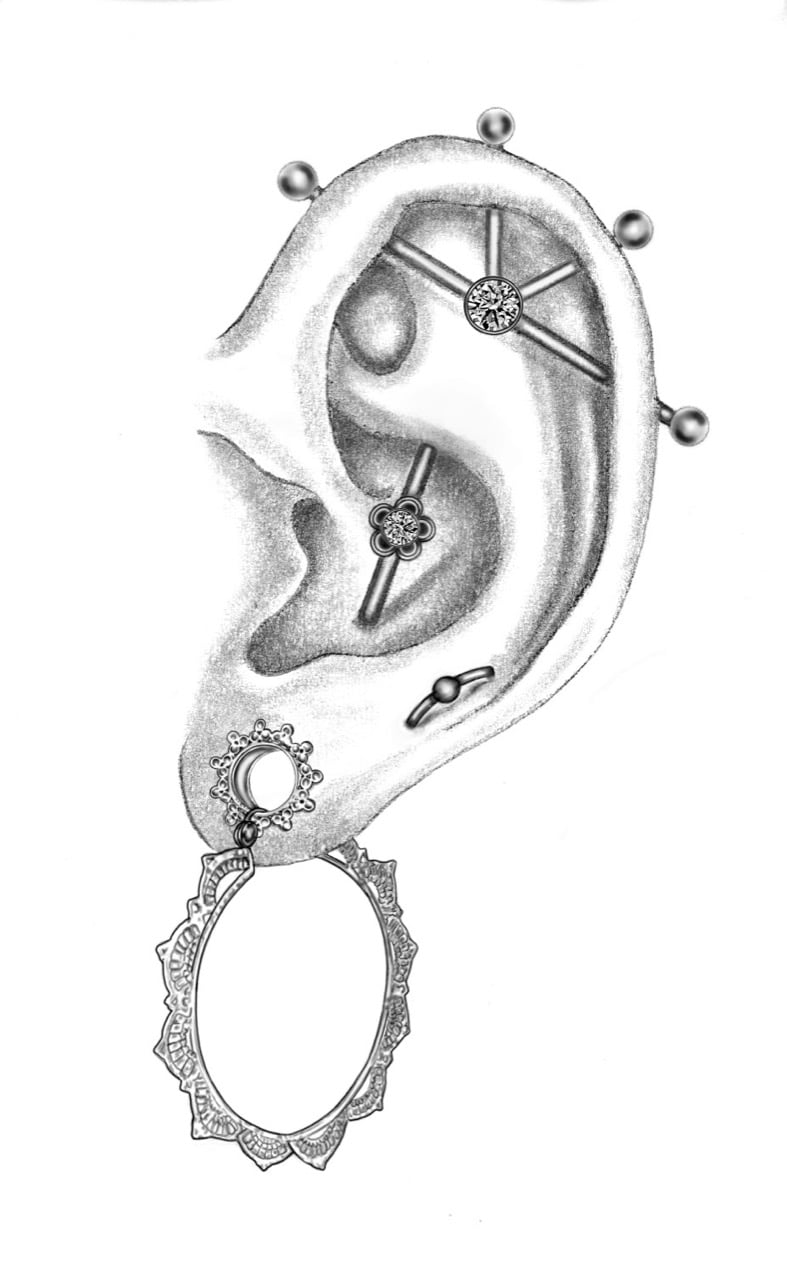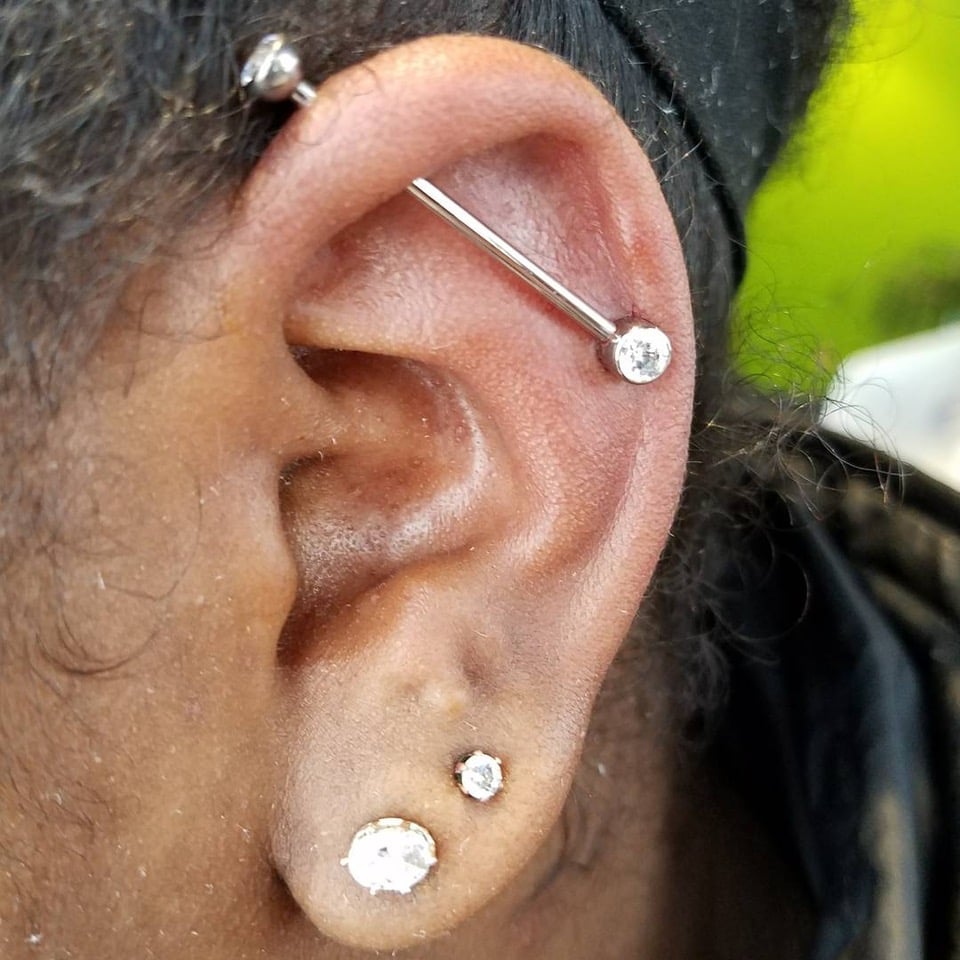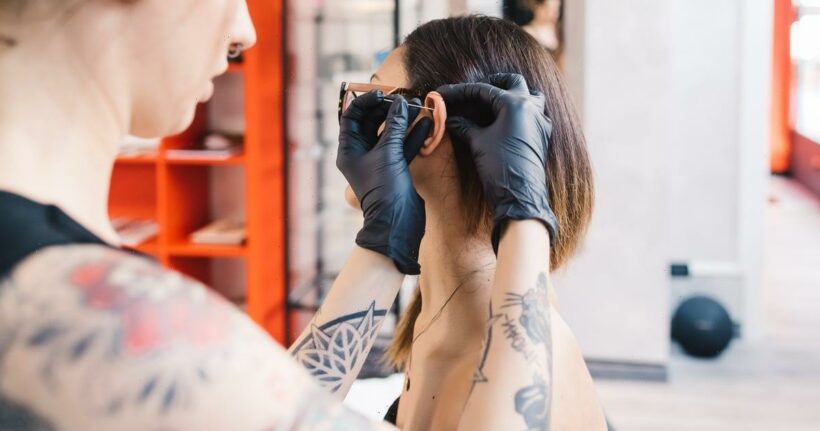
- Industrial piercings are a step up from traditional ear piercings.
- It typically encompasses two puncture holes instead of one.
- We asked a professional piercer to answer all of the most common questions regarding industrial piercings.
Though getting a piercing may have once immediately granted someone the not-so-distinguished title of “social outcast,” thanks to numerous celebrities and movies that have redefined what the image of “cool” is, piercings are now one of the most commonplace forms of body modification today.
Though they have now received a mainstream stamp of approval, piercing enthusiasts have still managed to create their own subculture within the space, putting creative spins on traditional piercings that we know and love. One version that’s been rising in popularity is the industrial piercing.
Differing from a helix piercing, which is “any piercing around the ‘rim’ of the cartilage of the ear,” Anna Girgan, director of in-store experience for Banter by Piercing Pagoda, previously told POPSUGAR, an industrial piercing is where “a single barbell that connects two or more piercings in the ear,” says Elayne Angel, author of “The Piercing Bible: The Definitive Guide to Safe Piercing.”
If you’re ready to take the plunge and get your own industrial piercing, we asked Angel to break down everything you should know, from pain level to the best types of jewelry to use, ahead.
What Are Industrial Piercings?
Also referred to as “scaffold” piercings in the UK and some other regions, the traditional configuration of an industrial piercing “threads a long barbell through two holes in the upper cartilage from close to the head to the curled outer edge of the ear (the helix),” says Angel. It is similar to an “orbital” piercing but that latter uses a ring rather than a bar to connect multiple piercings.
Different Types of Industrial Piercings

Though the most popular version is in the upper cartilage, there are quite a few variations to choose from. “One variation passes from the tragus through the conch, another pierces vertically behind the ear through the upper and lower edges of the conch, yet another option goes vertically through the top of the helix and then through the bottom of the conch,” says Angel. “The possibilities are limited by your imagination and, more importantly, your anatomy, in addition to the skill level of your piercer.”
There is also a type of industrial piercing that is not executed in the ear called the rare nasallang. “This is where both nostrils and the nasal septum are connected with a single barbell.”
Do Industrial Piercings Hurt?
Industrial piercings are typically done in the cartilage so “some tenderness is to be expected,” Angel says. Additionally, because it’s more than one piercing, “it should be expected to be more intense than a single puncture.” However, with a properly skilled piercer, the piercing should be quick, smooth, and efficient.
The Best Jewelry For Industrial Piercings

The jewelry used for industrial piercings is typically a long barbell but there are “many different gemstones and ornamental ends that can be used [on the bar],” Angel says. “One style has tapping drilled into the body of the bar so that threaded ornaments can be screwed into the post, and there are certain specialized component pieces (including ball-and-socket-style junctions) that lend themselves well to industrial piercing variations.”
Regardless of the style you choose, the bar must be made out of standard body jewelry materials. According to Angel, some examples are implant-certified steel, titanium, niobium, 14k or higher nickel, and cadmium-free gold.
Potential Risks of Industrial Piercings
As with any other piercing, rejection is possible, but the chance of rejection may be a bit higher with an industrial piercing. “Rejection and other complications are quite common when the anatomy is ill-suited,” says Angel. “It can also happen if the piercing placement is poor, [such as] too close to the edge of the ear or not aligned properly.”
If you do experience an issue, Angel says to consult a piercing professional right away. “They will let you know whether a jewelry change might help or if you need to abandon one or both piercings.” If after getting the piercing you find that migration is taking place, it’s crucial to remove the jewelry “to minimize tissue damage and scarring” before the body rejects it.
Industrial Piercing After-Care
“The industrial, and all cartilage piercings, routinely take six to nine months or longer to heal,” Angel says. However, this will not mean that your ear will feel sore the entire time. There are, however, a few steps that Angel says are crucial to follow to ensure proper healing. “Uphold your hygiene, maintain good health habits, avoid trauma to the piercing site, and clean your piercing.”
She suggests the Briotech Topical Skin Spray ($13) which contains hypochlorous acid. “[It’s an] antimicrobial and anti-inflammatory substance that is naturally produced by the white blood cells as part of the body’s immune response,” Angel says. “It fosters healing and is far more germicidal than saline but does not kill healthy cells the way soap or strong antiseptics do.”
Whether you’re only curious about industrial piercings or are making an appointment as we speak, keep these tips in mind to ensure that your experience is a smooth one.
Source: Read Full Article

